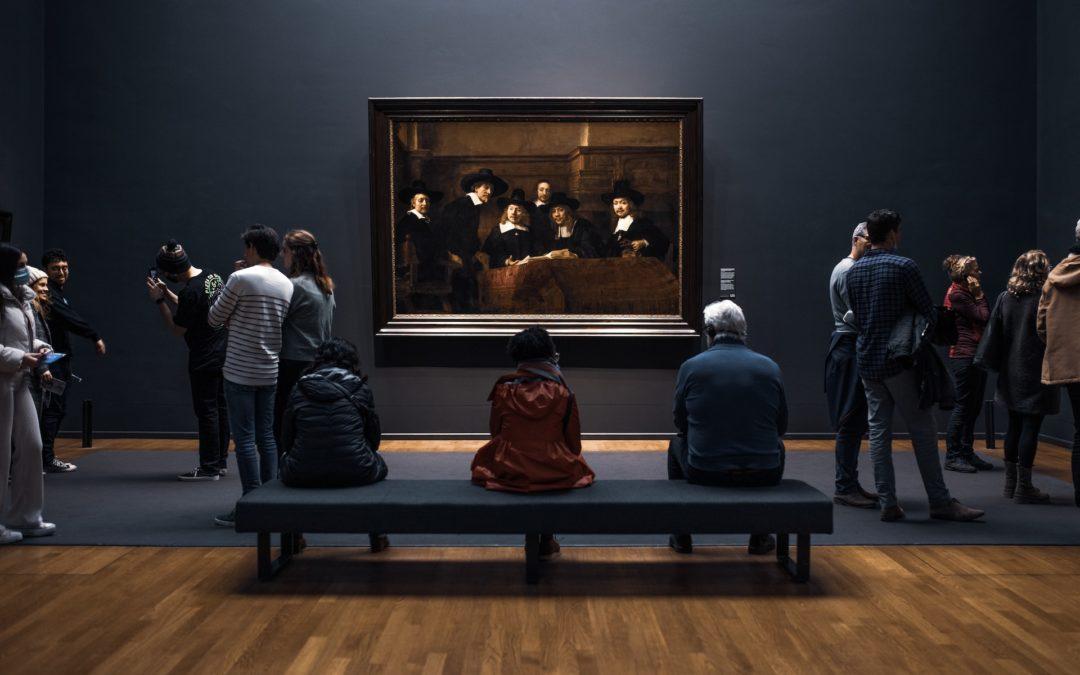Step into a realm where knowledge meets fascination, where every exhibit sparks curiosity and understanding. Beyond housing artifacts and artworks, museums foster a sense of connection, enabling individuals to engage with diverse perspectives and ideas. Discover how these institutions amplify learning, ignite creativity, and cultivate a deeper appreciation for our shared heritage. Join us on an insightful journey through the myriad benefits that come alive within the walls of these extraordinary spaces.
What is a Museum?
The Biggest Benefits of Visiting a Museum
1. Cultural Enrichment
Museums serve as custodians of the cultural wealth of diverse societies. Through the exhibition of artifacts and artworks, museums offer a tangible and visual representation of the customs, traditions, and artistic expressions that define a culture. Exploring these exhibits goes beyond mere observation; it becomes a journey into the soul of different societies, providing individuals with a profound and empathetic understanding of our shared global heritage.
2. Historical Insight
Museums act as time capsules, preserving and presenting the narrative of human history. They are living archives that showcase the evolution of societies, technological advancements, and the unfolding of ideas. Visitors are afforded a unique opportunity to witness history firsthand, fostering a connection with the past that transcends the confines of textbooks. This intimate encounter with history enriches our perspective on the present and shapes our collective identity.
3. Educational Value
Museums stand as invaluable educational resources, offering a dynamic and immersive learning environment. Unlike traditional classrooms, museums provide a hands-on approach to learning, allowing visitors to engage with subjects ranging from the sciences to the arts. The interactive nature of exhibits transforms education into a captivating experience, promoting curiosity and a lifelong passion for knowledge.
4. Art Appreciation
Art museums function as vibrant showcases of human creativity. They expose visitors to a kaleidoscope of artistic expressions, from classical masterpieces to contemporary installations. The experience fosters not only an appreciation for aesthetics but also an understanding of the cultural and historical contexts that shape artistic movements. Art museums, therefore, become platforms for fostering a deep and meaningful connection between individuals and the world of art.
5. Scientific Exploration
Science museums go beyond textbooks and classrooms, offering an engaging and interactive platform for scientific exploration. Through hands-on displays and exhibits, visitors can grasp complex scientific concepts with ease. The marriage of education and entertainment in these spaces sparks curiosity, making science accessible and enjoyable for individuals of all ages, thereby contributing to the development of a scientifically literate society.
6. Inspiration for Creativity
Museums, by virtue of their diverse exhibits, serve as incubators for creativity and innovation. Exposure to different artistic styles and historical periods can inspire individuals to think outside conventional boundaries. The amalgamation of ideas and perspectives becomes a catalyst for creative thinking, nurturing a mindset that values innovation and originality.
7. Cognitive Development
The act of visiting museums is a cognitive exercise in observation, critical thinking, and problem-solving. Navigating through exhibits prompts visitors to actively engage their minds, enhancing cognitive functions. Whether deciphering historical narratives or interpreting intricate artworks, the museum experience becomes a holistic workout for the brain, contributing to intellectual growth and mental acuity.
8. Civic Awareness
Museums often serve as platforms for addressing social and political issues. Exhibits that delve into these topics provide visitors with an opportunity to reflect on the complexities of the world. By fostering civic awareness, museums encourage individuals to think critically about societal challenges, contributing to the cultivation of informed and engaged citizens.
9. Family Bonding
Museums create a family-friendly environment, offering a space for shared experiences and learning. Family visits to museums become more than educational outings; they are opportunities for bonding and communication. Parents and children can explore, question, and discover together, creating lasting memories and instilling a positive attitude toward learning.
10. Multisensory Experience
Museums engage multiple senses, transforming the visit into a multisensory experience that transcends traditional learning. The combination of visual, auditory, and tactile stimuli not only makes the visit more memorable but also caters to diverse learning styles. This holistic approach ensures that individuals of varied preferences and abilities can fully immerse themselves in the museum experience.
11. Preservation of Cultural Heritage
Museums serve as custodians of cultural artifacts, safeguarding them for future generations. Through meticulous conservation efforts, museums ensure that these artifacts remain intact and accessible. This preservation not only protects the tangible expressions of a culture but also allows for the transmission of cultural knowledge and identity to posterity. Museums, therefore, play a crucial role in maintaining a continuum between past, present, and future, preserving the rich tapestry of human heritage.
12. Architectural Appreciation
Many museums are not only repositories of cultural treasures but are architectural marvels in themselves. The design and construction of these buildings often reflect artistic and engineering prowess. Visiting a museum becomes a dual experience—one of appreciating the artifacts within and another of marveling at the architectural ingenuity without. This appreciation extends beyond aesthetics, offering insights into the cultural, historical, and technological contexts that shaped the creation of these architectural gems.
13. Community Engagement
Museums are not just static institutions; they are vibrant hubs of community engagement. Beyond the exhibits, museums often host a variety of events, from lectures and workshops to community festivals. These activities foster a sense of belonging by bringing people together in shared spaces of learning and discovery. Museums, therefore, contribute to the social fabric of communities, promoting unity and a collective appreciation for knowledge and culture.
14. Experiential Learning
Interactive exhibits within museums transform learning into a dynamic and participatory experience. Rather than passively absorbing information, visitors actively engage with exhibits, touching, experimenting, and discovering. This hands-on approach to learning not only makes educational concepts more tangible but also fosters a deeper understanding through direct experience. Museums, therefore, become immersive classrooms where individuals can actively participate in the learning process.
15. Encouragement of Lifelong Learning
Museums inspire a love for learning that extends beyond the visit itself. The diverse and captivating nature of museum exhibits sparks curiosity and a thirst for knowledge. This inspiration often translates into a lifelong commitment to learning, encouraging individuals to explore and seek information independently. Museums, with their ability to kindle intellectual curiosity, become catalysts for a continuous journey of education and self-discovery.
16. Diverse Perspectives
Museums are powerful agents for broadening perspectives. By showcasing a wide array of artifacts and narratives, museums challenge preconceptions and provide a platform for diverse voices and stories. Visitors are exposed to different cultural, historical, and social perspectives, fostering a more inclusive understanding of the world. Museums, therefore, serve as bridges that connect individuals to the richness of human diversity, promoting tolerance and empathy.
17. Mindful Reflection
Amidst the hustle and bustle of everyday life, museums offer spaces for mindful reflection. Quiet corners within these institutions provide a sanctuary for contemplation. Visitors can take a pause, absorbing the cultural and historical richness around them, and reflecting on the significance of the artifacts on display. Museums become sanctuaries for introspection, offering a valuable break from the fast-paced external world.
18. Emotional Connection
Artifacts and exhibits within museums have the power to evoke emotions. Whether it’s a poignant historical artifact or a moving piece of art, the museum experience goes beyond intellectual engagement—it fosters a personal and emotional connection to the past or present. This emotional resonance adds depth to the learning experience, making it more meaningful and memorable.
19. Social Interaction
Museums provide a platform for social interaction. Whether through guided tours, workshops, or casual conversations among visitors, museums become social spaces where individuals can share their thoughts, questions, and insights. This social interaction not only enhances the overall museum experience but also creates a sense of community among visitors who share a common interest in exploration and discovery.
20. Promotion of Tolerance
Museums, by virtue of presenting diverse cultures and histories, contribute to the promotion of tolerance and understanding. Exposure to different perspectives challenges stereotypes and fosters an appreciation for the richness of human experiences. Museums, therefore, play a role in breaking down barriers, fostering empathy, and contributing to the creation of a more inclusive and tolerant society.
21. Stimulation of Curiosity
Museums act as catalysts for curiosity, igniting the inquisitive nature within visitors. The diversity of exhibits and the richness of information encourage individuals to ask questions, seek answers, and delve deeper into the subjects that capture their interest. Museums become dynamic spaces that not only provide information but also inspire a lifelong curiosity, fostering a mindset of continual exploration and learning.
22. Health and Well-being
Engaging in cultural activities, such as visiting museums, has been associated with improved mental health and overall well-being. The immersive and enriching experiences offered by museums provide a positive outlet for individuals to escape the stresses of daily life. The intellectual stimulation, emotional connections with exhibits, and the joy derived from learning contribute to a sense of fulfillment and mental well-being.
23. Technology Exploration
Museums often serve as showcases for cutting-edge technology, offering visitors insights into the latest advancements and innovations. Interactive displays, virtual reality experiences, and other technological features enhance the educational aspect of museum visits. This exposure to technology not only broadens visitors’ understanding of scientific and technological progress but also sparks interest and curiosity about the possibilities of the future.
24. Nature Appreciation
Natural history museums provide a gateway for visitors to explore and appreciate the wonders of the natural world. Through exhibits showcasing ecosystems, fossils, and biodiversity, visitors gain a deeper understanding of nature’s intricacies. This awareness fosters a sense of environmental responsibility and promotes conservation efforts by encouraging visitors to value and protect the planet’s natural resources.
25. Personal Growth
The diverse range of exhibits within museums contributes to personal growth by exposing visitors to new ideas and perspectives. Whether it’s encountering different cultures, historical events, or artistic movements, each exhibit offers an opportunity for intellectual and emotional expansion. Museums become spaces for self-discovery, encouraging individuals to reflect on their beliefs, values, and the world around them.
26. Connection to Local History
Local museums serve as portals to the history and heritage of a specific region, fostering a profound connection to local roots. By preserving and showcasing artifacts relevant to the community’s history, these museums contribute to a sense of local pride. Visitors, whether residents or newcomers, gain insights into the cultural evolution of the area, fostering a shared understanding of the community’s identity.
27. Interdisciplinary Learning
Museums often transcend traditional academic boundaries, bridging gaps between different disciplines. Exhibits may incorporate elements of history, science, art, and technology, providing visitors with a holistic and interdisciplinary learning experience. This approach encourages a more integrated understanding of complex subjects and promotes a mindset that values the interconnectedness of knowledge.
28. Accessible Learning
Museums cater to various learning styles, ensuring that knowledge is accessible to people with different preferences and abilities. Visual learners can appreciate artworks, hands-on exhibits engage tactile learners, and informative displays accommodate those who prefer reading. By offering a diverse range of educational approaches, museums democratize learning, making it inclusive and enjoyable for a wide audience.
29. Nostalgia and Reminiscence
Historical exhibits within museums have the power to evoke feelings of nostalgia, transporting visitors to different eras and connecting them with the past. The tangible artifacts and immersive storytelling allow individuals to reminisce about shared cultural experiences or personal memories. This emotional connection to the past contributes to a sense of continuity and historical awareness.
30. Community Identity
Museums contribute significantly to the identity of a community by preserving and showcasing its unique history and culture. By exhibiting artifacts, artworks, and narratives specific to the locality, museums become cultural hubs that reinforce a shared sense of belonging. Residents and visitors alike can appreciate and celebrate the distinctive features that define the community’s identity, fostering a sense of pride and unity.
What are the 5 Functions of Museum?
Museums serve as custodians of our shared human experience, playing vital roles that transcend mere repositories of artifacts. First and foremost, these institutions serve as educators, wielding the power to enlighten and inform. They unravel the mysteries of history, science, art, and culture, offering immersive experiences that ignite curiosity and spark intellectual growth.
Beyond education, museums act as preservers of heritage, safeguarding our collective memory. Through meticulous curation and preservation efforts, they protect invaluable artifacts and artworks, ensuring their survival for future generations. These spaces become time capsules, encapsulating the essence of civilizations past and present.
Moreover, museums serve as social hubs, fostering community engagement and dialogue. They transcend geographical and cultural boundaries, inviting individuals from diverse backgrounds to converge, share ideas, and engage in discourse. Whether through exhibitions, events, or workshops, they stimulate conversations that transcend the walls of the institution.
Additionally, these bastions of knowledge and creativity serve as catalysts for inspiration and imagination. By showcasing the triumphs of human ingenuity, museums kindle creativity and innovation. They become fertile grounds for new ideas to germinate, motivating individuals to explore, create, and push the boundaries of conventional thinking.
Finally, museums contribute to the economy, acting as tourist magnets that stimulate local businesses and infrastructure. They attract visitors, both domestic and international, injecting vitality into surrounding communities while generating revenue that sustains their operations and further cultural endeavors.
In essence, museums are not mere repositories of artifacts; they are dynamic entities that weave a rich tapestry of education, preservation, community, inspiration, and economic impact, shaping our understanding of the world and our place within it.
Importance of Going to a Museum
Going to a museum is important because it helps us learn about our history and culture. Museums keep old things, like artifacts and artworks, so that we and future generations can see them. They are like big classrooms where you can learn in different ways, like touching and seeing cool things. Visiting museums can make us feel happy and less stressed, like taking a break from everyday life. They also make us curious and interested in learning new things. Museums often have events that bring people together, making us feel connected as a community. Plus, museums show us how things have changed over time and teach us about new inventions. In simple terms, going to a museum is like taking a fun and interesting journey to explore and understand our past and present.
Read also: Top 30 Paradigm Examples Across Fields
The Most Popular on BitGlint

Top 100 Optimism Examples & Definition
Optimism is more than just looking on the bright side. It’s a mindset that shapes how people face challenges, make...

60 Things That are Unpredictable
No matter how much we plan, life has a way of surprising us. Some things follow a routine, but others can change in an...

30 Wishful Thinking Examples & Meaning
Wishful thinking is something we all do at some point. You hope things will turn out fine—even if there’s no real...

100 Things That Come in Pairs
Pairs are all around us. From what we wear to how we live, many of the things we use or see every day come in twos....

20 Frequency Examples in Daily Life and Physics
Have you ever noticed how often things repeat in everyday life? Maybe it’s the steady ticking of a clock, the rhythmic...

20 Infinity Examples & Definition
Infinity is one of the most powerful ideas people have ever thought about. It shows up in math, science, philosophy,...

30 Examples of Pragmatism & What It Really Means
What does it really mean to be pragmatic? It’s a word people often hear, but not everyone fully understands. In...
Get Inspired with BitGlint
The Latest
30 Moral Reasoning Examples & Definition
Moral reasoning is something most people use every day, often without even realizing it. It’s the thought process behind the choices we make when we’re trying to figure out what’s right and what’s wrong. These choices happen in simple moments—at home, at work, with...

100 Things That Are in The Sky
The sky is full of things - some you see every day, others only once in a while. Some are natural, like clouds and stars. Others are made by people, like airplanes and satellites. From quiet sunsets to loud rocket launches, the sky is never empty. People have been...
20 Hinduism Examples: Symbols, Gods & Core Beliefs
Hinduism is practiced by over a billion of people every day - but for those unfamiliar with it, it can seem complex or even confusing. With its many gods, rituals, and traditions, it raises a lot of questions. What do Hindus actually believe? What are the main...
40 Social Dilemma Examples in the World & Real Life
Social dilemmas are everywhere. They shape the choices we make at work, in our communities, and even on a global scale. These dilemmas happen when what benefits an individual might hurt the larger group. When too many people act in self-interest, it can lead to bigger...

